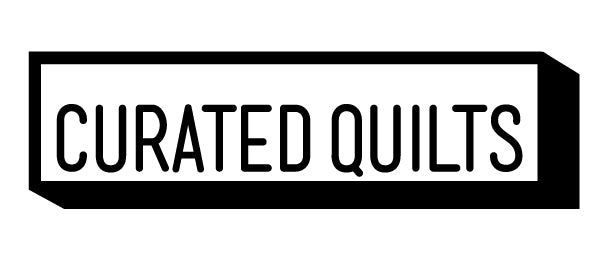‘Home’ means different things to each of us. Sometimes ‘home’ embodies a physical place where we go for shelter from the noise and movement of the outside world. Sometimes home is found in a group of friends we feel comfortable around. For a quilter, echoes of home are sewn into the quilts we make. We stitch our personality, our hopes, and happiness, our worries and sadness into the fabric. Whether hung on walls, draped on beds, or wrapped around us, quilts provide the comfort of a safe place to land. They make a dwelling more like home.
Blue Houses by Melanie Tuazon
Blue Houses is representative of living in the suburbs and is a great example of how scale can create depth. The windows of the house are a strong focal point and they create movement throughout this modern neighborhood.
Eichler Homes by Mickey Beebe
Mickey Beebe was inspired by the iconic Eichler homes when she created this quilt. Joseph Eichler (1900-1974) was a visionary real estate developer who brought modern, well-designed, affordable housing to the general public. Most of the 11,000 houses he built were in the greater San Francisco Bay area. He was a proponent of fair housing and was deeply opposed to racial discrimination and was the first large tract builder to sell homes in his developments to minorities. Eichler Homes was originally created for a QuiltCon triangle challenge and has hung in multiple national quilt shows.
Mapping Earth by Alicia Merrett
Alicia Merrett is fascinated by maps. She believes they are an ancient and important part of mankind’s need to interpret and understand the world. Maps are also a sort of journal of human living. Mapping Earth represents the crossroads that can be found in English villages. The use of the color red in ‘the village’ portions of the quilt shows the heart that can be found in the places we live.
Grid by Riane Menardi Morrison
Riane Menardi Morrison says Grid was inspired by the foundation of a house. The crosshatch hand-quilting represents the structured support systems of being home-- both physically and emotionally. Natural fibers were intentionally chosen to create an added layer of the hominess and comfort that is associated with being home.
Metropolis by Pam Rocco
Once Pam Rocco began stacking her tall, columned houses on top of one another, she says they started looking like the futuristic buildings in the 1927 movie Metropolis by Fritz Lang. The stacked houses are the perfect demonstration of a living city. The way Rocco used negative space with her inverse house shapes and color choices in the top corners of the quilt creates a sense of sky, giving the dense housing space to breathe.
Clerestory by Debbie Grifka
The house motif has been used in quilts for hundreds of years. Grifka has brought the traditional house quilt into the 21st Century with her modern ranch house pattern. The addition of ‘vacant lots’ to the neighborhood in Clerestory is an example of how negative space adds interest to a quilt and provides a soft place for the eye to rest.
Supply is limited, but back-copies of Curated Quilts: ‘House’ are still available! Find these quilts and more when you purchase Curated Quilts: ‘House’.
by Brittany Bowen Burton

Lovely post
Lovely article; I am eager to receive the House issue.